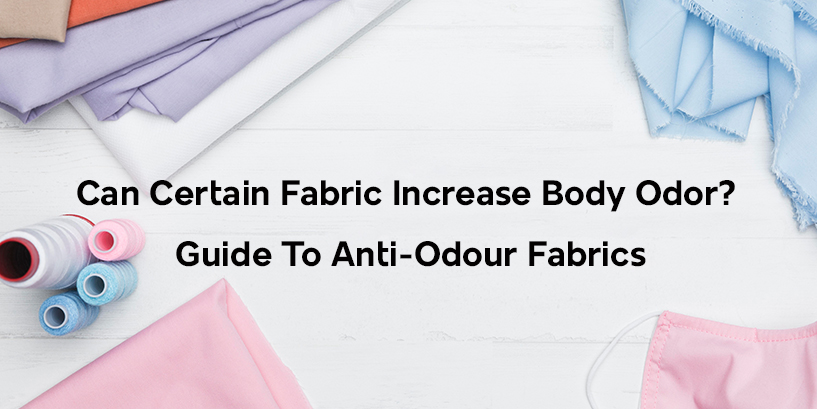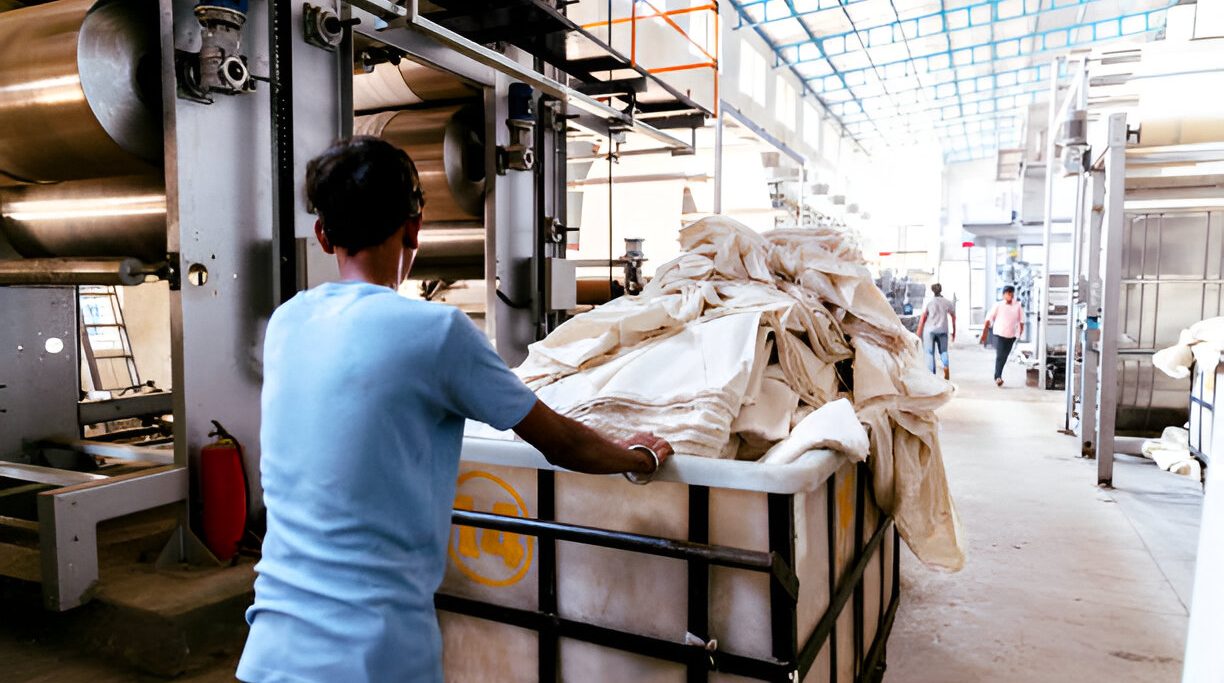Have you wondered at times, if your body odour could have some connection to the fabric you wear? Well you could be right! It turns out that the choice of fabric that you wear can affect your body odour. Body odour is a natural phenomenon produced by every human being. The sweat acts as a magnet attracting the bacteria present on the skin, resulting in a smelly by-product called body odour.
While there are many causes for body odour, one of the primary reasons could also be the food we eat, the clothes we wear or even as simple as not following hygienic ways.
So, can certain fabrics increase body odour?
Yes, the kind of fabric you wear can increase your body odour. Man-made fabrics especially like nylon and polyester increase body odour. Because of their chemical composition, molecules of these fabrics are closely packed together, making them better insulators that produce heat and capture moisture and cause a strong odour. On the other hand, synthetic fibres are tightly woven and do not absorb moisture that gets accumulated in the body.
Which is the best fabric for you to wear then? Anti-odour fabrics inhibit bacterial growth and are the recommended garment fibre that keeps your body odour-free. So if you are worried about body odour why not simply try using anti-odour fabrics?
Can Certain Fabrics Increase Body Odour?
There is a list of anti-odour fabrics that will keep your body odour at bay.
When it comes to fabrics, there are literally many that you can choose from all – natural, or synthetic These anti-odour fabric will help you mitigate the body stink bugging you.
Moreover, the breathability of odour resistant fabrics keeps your body temperature optimum and breezy throughout the day, making the wearing comfortable. The primary mechanism of how an anti-odour fabric works is that it prevents the growth of microorganisms which is the result of accumulation of bacteria and sweat, leading to a stink if not prevented.
Here are some features of anti-odour fabric that make it a preferable alternative:
- The fabric can absorb odorous gases and include antimicrobial factors in it
- It is endowed with deodorising technology that keeps your body odour more petite and fresh
- Anti-odour fabric has the ability to pacify the odour of ammonia, and muskiness resulting from sweat
- These fabrics are based on anti-fabric technology that captures and diminishes the odour-causing bacteria, curbing the body odour to a large extent
- It reduces the chance of cross-infection outdoors
An anti-odour fabric also proves harmless to humans and the environment. Depending on which anti-odour fabrics are made to minimise the unruly skin odour, there are two ways.
Antimicrobial chemicals: In this methodology, two antimicrobial triclosan and triclocarban are used to weaken the cell membrane of the microbes so that they can’t contribute to the body odour.
Silver technology: Another popular microbial element is silver. It diminishes the bacteria after oxidising. Hence, it is used in fibres to make anti-odour garments. Silver is added to synthetic fibres like spandex and polyester to reduce bacterial growth, thereby reducing body odour. It is primarily used in workout wear, leggings, socks, etc.
Zeolites: Zeolites are volcanic ashes that are combined with alkaline water. These volcanic ashes are mixed with odour-resistant agents, which results in the absorption of the odour molecule by the ash molecule, barring the odour molecule from scattering its characteristic smell.
Hydrogen peroxide, known as a bacteria-killing powerhouse, is another proven effective means of curtailing the toxic ability of the bacteria and is often used as a disinfectant. Treating fabrics with hydrogen peroxide reduces the ‘odour’ quotient.
Fabrics are also available in moisture wicking cloth, but these are different from an anti-odour fabric. Moisture wicking cloth gives a cooling effect to your body and are often used in athletic or workout clothes. However, it does not control the body-odour. On the other hand, anti-odour fabric minimises body odour and bares the bacteria from reacting with the sweat.
It is generally advised to avoid frequent washing of the anti-odour garments, in order to enhance their longevity.
Before choosing anti-odour clothing, you also need to consider its efficacy and safety. In case you are searching for a fabric that is not endowed with anti-odour technology, you can indeed shift to natural fabrics like bamboo, linen, cotton, pashmina, etc.
Natural fibres provide a soothing effect and act as excellent ventilation. The natural texture and microscopic fibre regulate body temperature. It keeps your body temperature at certain degrees below the outside temperature. Almost all natural fabrics are bestowed with self-thermal adjusting potential. Moreover, they are sustainable and environment-friendly as they decompose without affecting Mother Nature.
Here are some natural fibres that you can choose to avoid body odour-
Cotton: Cotton clothing acts as a sponge as it has water retention capacity, hence soaking sweat and helping the skin breathe. It does not trap the body smell like the synthetic fibres do, helping both bacteria and sweat evaporate and keep your body odour free and make you feel comfortable. Even if you are wearing a different fabric, try using a bodysuit made of 100% cotton that will absorb the sweat.
Bamboo: It’s time you stock some bamboo based garments in your closet. Did you know bamboo wicks 40% more sweat than regular cotton fabric? It can soak sweat away from the skin and keep you dry for an extended period. Are you impressed already with the fabric? Moreover, bamboo based clothing regulates body temperature and has higher durability. It has a bacteriostatic antifungal agent that makes this fibre odour-resistant and anti-bacterial. It does not go through chemical treatment; it is hypoallergenic and incredibly soft on the skin.
Linen: Linen clothing allows air to flow into the body and is naturally microbial; protecting the body from being smelly. It keeps the skin dry and reduces perspiration. No matter how badly you sweat, linen clothing will keep your skin dry. It is more durable than cotton and is the most preferred fabric for hot and humid weather. Moreover, its lightweight, thermo regulating feature has made it a scale pyramid of comfortable clothing. It is also suggested for curing skin rashes and eczema.
Wool: In a woollen fabric, the moisture is trapped on the outer layer of the fabric; hence microbes do not get the chance to grow inside your clothing. Wool is also an odour resistant and hygroscopic fabric and can readily absorb a large quantity of water, preventing the accumulation of sweat and resultant unpleasant stinks. In addition, woollen material binds body odour, not letting infectious bacteria thrive. Even wool can absorb 36% of moisture content and is thus an excellent choice to reduce body odour.
Cotton, jute, and linen are primarily used in summers to keep the body brisk and allow the passing of air, helping sweat absorption or producing a drying effect. Even wool helps with cross ventilation, allowing air passing and keeping warm but stink-free.
Why do artificial fabrics lead to body odour? So, let’s refer to the body heating and thermal activity that helps us get warm in the cold. This is why we wear heavy clothes or use blankets; the atmosphere is trapped amidst the clothing/blanket, producing heat and keeping us warm. Now, if the same air were to seep in and out of the fabric, we would start feeling cold, and it would be breezy, causing a flow of air and keeping our body temperature normal. This is the exact science behind engineering clothes for different weather, using specific fabrics for making clothes and using different areas and weather conditions.
There is an apparent connection between fabrics and body odour. However, if you want to prevent the muskiness, shift to wearing breathable fabrics and organic handmade garments will free you from such concerns.
Know The Fabrics To Avoid Wearing
It’s high time to pay attention to the fabrics touching your body regularly. Artificial fabrics like polyester, nylon, acrylic, spandex, synthetic fur, olefin, nylon, neoprene, etc., add to the body odour. Being hydrophobic and oleophilic, these fibres provide an optimal environment for bacterial growth, intensifying the body odour. Albeit, these fabrics wick away perspiration, some amount of oil is left behind, which worsens the body odour.
Though there is pomp and show around artificial fabric tempting you to purchase it;the fact that it is not natural and has an adverse effect on the skin.
It is because of the non-natural material and synthetic construct of the fabric that results in the escalation of the body odour. In addition, these synthetic fibres are subjected to faster evaporation of sweat, making it vulnerable for bacteria to grow and increase muskiness.
Polyester: Synthetic fibres like polyester traps moisture and do not allow airflow. The sweat particles get collected in the nooks and crannies of the fibre, allowing bacteria to feast over it and make a breeding ground for themselves, resulting in the body odour.
Spandex: Since the material is non-absorbent, it smells due to bacteria. Hence, try avoiding the use of spandex and shift to breathable fabrics.
Nylon: Both nylon and polyester are known for their moisture wicking capacity and trap the sweat molecule inside the body, resulting in the production of body odour.
Artificial fibres are made up of minuscule notches that hold sweat from the cloth’s inner side and lead to a strong stink.
Being nonporous and impermeable, these fabrics develop a strong odour which does not fade away even after repeated washing. These fabrics agitate certain skin conditions by blocking moisture and providing a perfect ecosystem for breeding microbes.
Several other reasons are responsible for body odour. The eccrine gland is responsible for regulating body temperature. Body odour is primarily odourless. It is the apocrine gland that leads to the body odour. Any change in the hormones results in body odour.
- Your sweat can smell bad due to underlying health conditions like diabetes, gout, kidney disease, etc.
- It can also result due to heavy exercise
- It also depends on your diet, and medications
Tips To Prevent Body Odour
If a synthetic, man-made fabric increases body odour, why use them? Instead, dump the artificial fabrics and shift to using anti-odour and natural fabric. Sticking to natural and anti-odour garments is the best thing you can do to avoid an unpleasant body odour.
Besides considering the type of fabric, you can also glance through the following pointers to avoid body odour-
- Keep your body squeaky clean and prevent bacterial growth
- Wash your clothes and change them if your body is sweating heavily
- You can also try using antiperspirants on areas that tend to sweat more. For example, you can try using it after taking a shower. It will help wash accumulated sweat from the body
- Try cutting out foods that affect tempers with temperature. For example, food like hot peppers, and excessive consumption of onions and garlic should be curbed to prevent body odour.
- Another crucial factor is to choose the fabric of your clothing wisely
The main thing to curb skin odour is to keep your skin dry as bacteria tend to replicate in damp and moist areas.
In conclusion, can certain fabrics increase body odour? The short and crisp answer is yes; some fabrics increase body stink. However, body odour is a usual occurrence. Hence, a gradual shift towards anti-odour and natural fabrics will significantly impact how your skin smells. With the availability of newly engineered body-odour resistant fabric, you can now effectively lower body odour and walk around feeling confident and comfortable in your own skin.



